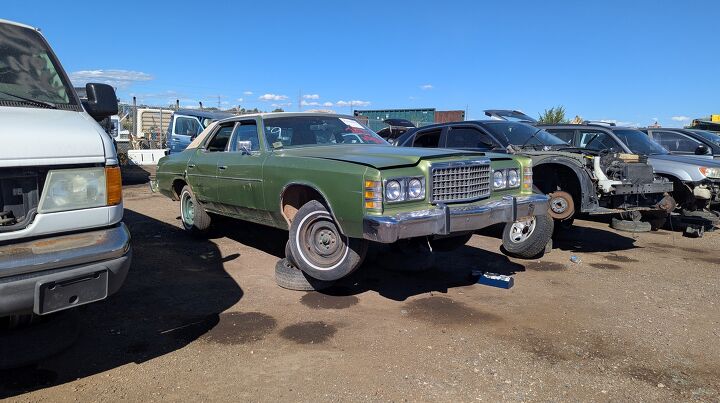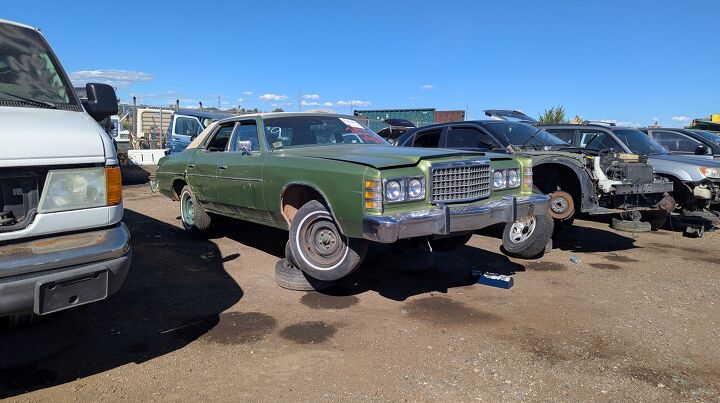When I spot a Malaise Era product of the Ford Motor Company while making my junkyard rounds, I like to text photos of them to our friend Sajeev Mehta and get his bitter tears a-flowing. My favorite Denver-area yard now boasts two such cars from the year of America’s Bicentennial: a Mercury Marquis and this Ford LTD, both 4-door pillared hardtops.

This generation of North America-market full-sized Ford was a spectacular sales success for Dearborn. It was built for the 1969 through 1978 model years and lived under way too many different Ford and Mercury badges to list here. There were coupes, convertibles, 4-door hardtops, sedans and station wagons.

The LTD name began life as an upscale trim level designation for the 1965 Galaxie. For 1966, the LTD became a model in its own right, and it lived at the very top of the full-size Ford prestige ziggurat.

From that point through 1974, full-sized Fords came in three models: the entry-level Custom, the mid-grade Galaxie and the high-zoot LTD (for parts of that period, the “500” designation appended to the model name indicated a somewhat nicer version). The first car I remember riding in as a kid was my dad’s 1967 Custom two-door sedan (shown in the 1970 photo above); it had a 289 with overdrive-equipped three-speed manual transmission.

By 1976, the US-market full-size Ford line was down to just the LTD and the Custom, and the Custom was for fleet buyers only. This simplified marketing but also meant that the big Ford’s Mercury Marquis sibling had an uncomfortably similar price tag for a car that was supposed to be a big step up in bragging rights.

The MSRP for a top-of-the-line 1976 LTD Landau four-door was $5,560, while the base 1976 Marquis four-door listed at a much cheaper $5,063 (those prices would be $32,398 and $29,502, respectively, in current dollars). Buyers of the much grander Grand Marquis four-door that year would have had to bring up their cars’ $6,528 price tags ($38,035 after inflation) in order to make LTD Landau owners feel inferior.

Regardless of which brand and model you chose, you got a lot of car per dollar when you bought a big Ford or Mercury in 1976. This car’s MSRP was $4,752, or about $27,489 in today’s money. What kind of new Ford can you buy for that kind of price right now? Just one: the base $28,145 Maverick.

Before you start banging on your keyboard about how much more expensive new cars are today versus a half-century ago, keep in mind that 2025 vehicles have generous helpings of standard features that would have been expensive options in 1976. For example, the “digital” clock, AM radio and air conditioning you see in this photo represent a total of $607 ($3,537 now).

That’s just the beginning of the extras I saw on this car (which I thought must have been a Brougham at first glance but turns out to be just an optioned-up base LTD), but you get the idea. By the time its buyer left the showroom, it cost well over $35k in present-day dollars.

That transaction took place at a dealership just a few miles away from this LTD’s current parking spot, in Englewood’s once-thriving Auto Row on South Broadway.

Adding a bit of local history, here’s this 1984 City of Longmont Parks & Recreation Department swim pass that I found under the rear seat. I looked up the holder’s name online and learned that she still lives in the area.

This LTD was a regular visitor to Colorado State Parks in 1987.

This bumper sticker represents the US Army’s 89th Infantry Division, which fought in both World Wars and trained in Kansas, Nebraska and Colorado.

The build tag on the door was completely indecipherable (which is unusual for Fords of this era but nearly universal in mid-1970s GM cars), but I learned from the VIN that this car was born at Ford’s Los Angeles Assembly factory in Pico Rivera.

That’s interesting, because it seems that most big Fords of this era sold in Colorado were built at St. Louis Assembly or St. Paul Assembly. Los Angeles Assembly was bought by Northrop in 1982 and used for the secret development of the B-2 Spirit bomber; today, it’s the site of a shopping mall. There’s a lot of history in the junkyard, if you know where to look!

The base engine in the 1976 LTD was a 351M V8 rated at 152 horsepower and 274 pound-feet. An automatic transmission was standard equipment (the last year for a manual transmission in a new LTD was 1970, while three-on-the-tree manuals lasted through 1971 in the Custom).

However, this car was built with the optional 400, essentially a stroked 351 Cleveland. It was rated at 180 horsepower and 336 pound-feet, which helped move the LTD’s 4,303 pounds but must have felt like a liability in the aftermath of the 1973 and 1979 oil crises.

Very few Front Range car enthusiasts care to rescue bread-and-butter Detroit four-door sedans like this one, especially ones with rust-through.

I’ll bet it was a runner when it arrived here. Next stop: The Crusher.

1976 Ford LTD in Colorado junkyard.

1976 Ford LTD in Colorado junkyard.

1976 Ford LTD in Colorado junkyard.

1976 Ford LTD in Colorado junkyard.

1976 Ford LTD in Colorado junkyard.

1976 Ford LTD in Colorado junkyard.

1976 Ford LTD in Colorado junkyard.

1976 Ford LTD in Colorado junkyard.

1976 Ford LTD in Colorado junkyard.

1976 Ford LTD in Colorado junkyard.

1976 Ford LTD in Colorado junkyard.

1976 Ford LTD in Colorado junkyard.

1976 Ford LTD in Colorado junkyard.

1976 Ford LTD in Colorado junkyard.

1976 Ford LTD in Colorado junkyard.

1976 Ford LTD in Colorado junkyard.

1976 Ford LTD in Colorado junkyard.

1976 Ford LTD in Colorado junkyard.
[Images: The Author]
Become a TTAC insider. Get the latest news, features, TTAC takes, and everything else that gets to the truth about cars first by subscribing to our newsletter.


